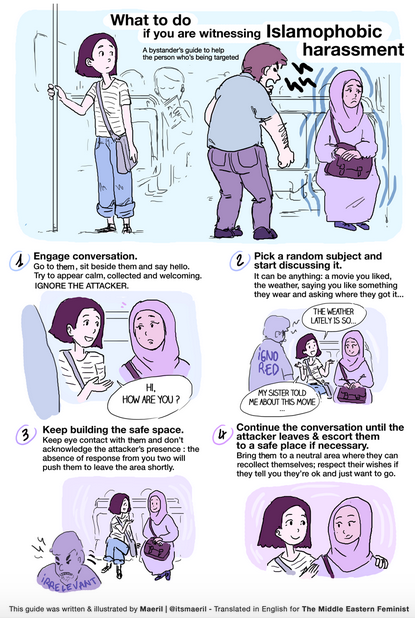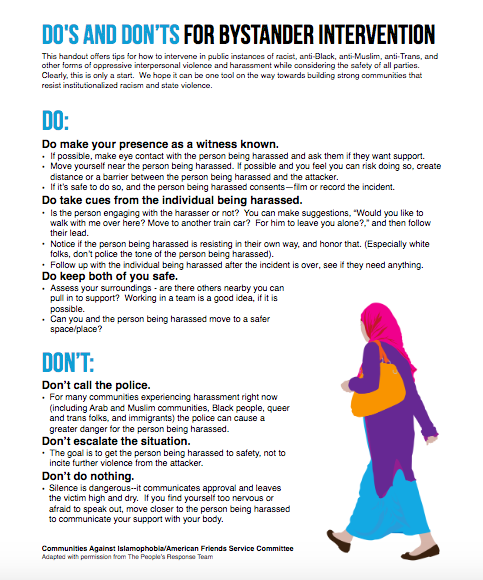// Muslim women, facing rising harassment and abuse, are stepping onto the frontlines of self defense training. Here’s a short video featuring a technique to resist a hijab grab and take the attacker down.
// Living in Liberation: Boundary Setting, Self-Care and Social Change is a great visionary resource by Home Alive co-founder Cristien Storm. Cristien argues that responses to violence can and should embody boundary setting, self care, and self defense skills that interrupt victim-blaming, fear-based approaches and locate healing within the social context of community. This groundbreaking text roots boundary setting and self care in larger visions of happier and healthier communities, all the while holding on to the complexities of individual safety and social justice.
// Self care and healing are vital parts of self defense. As violence often gets passed down in repeating cycles through families and communities, self care and healing are necessary to help us check our own tendencies to perpetuate learned unhealthy and abusive behavior toward others. We have to work on our personal stuff, deal with our traumas, and be tender with ourselves and each other in order to become the badasses that we know we have the power to be. Check out somatics practices, such as those taught by Generative Somatics,for one powerful method of getting deep while staying engaged.
// Creative practice can be used to generate social change. One change-generating creative tool, which we use to strengthen our role play exercises, is Theater of the Oppressed.
// Bystander intervention skills are becoming more important every day. How can we build our skills and confidence to interrupt harassment and abuse when we witness it? Here is one technique, illustrated by Maeril.

Here is a handy flyer from American Friends Service Committee, featuring 6 useful tools. This is the link: https://www.afsc.org/resource/dos-and-donts-bystander-intervention

Here’s a video with tips on how to intervene in racist and transphobic attacks.
And here is another short video illustrating five ways to disrupt racism, featuring more helpful tools for bystander intervention.
The Girl Scouts also have an anti-bullying/bystander training called Power Up.
// Under our punitive criminal legal system, people who cause harm to others are often treated as uniformly bad, subjected to a lock great ’em up and throw away the key ideology. We believe that, beyond ‘just’ being steeped in white supremacy, this authoritarian approach disempowers communities, denies people’s ability to change and perpetuates more violence. For an inspiring and visionary community alternative to dealing with abuse and violence, look at the new models of Transformative Justice currently being developed by visionary organizations like generationFIVE.
// “I am not proposing that sexual violence and domestic violence will no longer exist. I am proposing that we create a world where so many people are walking around with the skills and knowledge to support someone that there is no longer a need for anonymous hotlines. I am proposing that we break through the shame of survivors (a result of rape culture) and the victim-blaming ideology of all of us (also a result of rape culture) so that survivors can gain support from the people already in their lives. I am proposing that we create a society where community members care enough to hold an abuser accountable so that a survivor does not have to flee their home. I am proposing that all of the folks that have been disappointed by systems work together to create alternative systems. I am proposing that we organize.” – Rebecca Farr, Communities Against Rape and Abuse
This quote is on page one of the exciting new anthology from South End Press, The Revolution Starts at Home: Confronting Intimate Violence Within Activist Communities. Edited by Ching-In Chen, Jai Dulani, and Leah Lakshmi Piepzna-Samarasinha, this new book offers stories, strategies, and resources for tackling violence and abuse close to home without relying on the state.
// But how do communities actually take on the challenging, long-term work of holding its members accountable and creating safer spaces? Creative Interventions was established in 2004 as a resource center to create and promote community-based responses to interpersonal violence. The StoryTelling and Organizing Project is a community project collecting and sharing stories of everyday people ending violence through collective, community-based alternatives, offers inspiration and real-life examples. Creative Interventions also offers a comprehensive Toolkit for anyone interested in carrying out a community-based intervention to violence.
// Her Wits About Her is a powerful anthology that relates dozens of true self defense success stories by women, dispelling the pervasive myth that it’s better not to fight back. This book demonstrates how often a combination of strategies (yelling, negotiating, striking, positive self talk) can be incredibly effective in dangerous situations. Edited by Denise Caignon and Gail Groves.
// Home Alive used to be a nonprofit organization but now exists in a different form. Learn more about the nonprofit industrial complex in an anthology called The Revolution Will Not Be Funded by Incite: Women of Color Against Violence.
